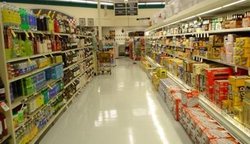Supermarket
|
|
Albertsonstorrance.jpg
A supermarket is a store that sells a wide variety of goods including food and alcohol (where permitted), medicine, clothes, and other household products that are consumed regularly. It is often part of a chain that owns or controls (sometimes by franchise) other supermarkets located in the same or other towns; this increases the opportunities for economies of scale. The chains themselves are often supplied from the distribution centers of a larger business.
Supermarkets usually offer products at low prices by reducing margins. Certain products (typically staples such as bread, milk and sugar) are often sold as loss leaders, that is, with negative margins. To maintain a profit, supermarkets attempt to make up for the low margins with a high volume of sales, and with sales of higher-margin items. Customers usually shop by putting their products into trolleys (shopping carts) or baskets (self-service) and pay for the products at the check-out. At present, many supermarket chains are trying to reduce labour costs further by shifting to self-service check-out machines, where a group of four or five machines is supervised by a single assistant.
A larger full-service supermarket combined with a department store is known as a hypermarket. Other services that supermarkets may have include cafés, creches, photo development, pharmacies, and/or petrol stations.
| Contents |
History
Early retailers did not trust their customers. In many stores, all products had to be fetched by an assistant from high shelves on one side of a counter while the customers stood on the other side and pointed to what they wanted. Also, many foods did not come in the individually wrapped consumer-size packages taken for granted today, so a clerk had to measure out the precise amount desired by the consumer. These practices were obviously labor-intensive and quite expensive.
The concept of a self-service grocery store was developed by Clarence Saunders and his Piggly Wiggly stores. A&P was the most successful of the early chains in the United States, having become common in American cities in the 1920s. The general trend in retail since then has been to stack shelves at night and let the customers get their own goods and bring them to the front of the store to pay for them. Although there is a higher risk of shoplifting, the costs of appropriate security measures will be ideally outweighed by the economies of scale and reduced labor costs.
The first true supermarket in the United States was opened by ex-Kroger employee Michael J. Cullen, in August 1930 in a 6,000 square foot (560 m²) former garage in Jamaica, Queens, New York. The store, King Kullen, following King Kong, operated under the slogan "Pile it high. Sell it low." When Cullen died in 1936, there were fifteen stores in operation.
Supermarkets proliferated in the United States along with suburban areas after World War II. Supermarkets in the USA are now often co-located with department stores in strip malls and are generally regional rather than national. Kroger is probably the closest thing in the U.S. to a national chain but has preserved most of its regional brands like Ralphs.
It was formerly common for supermarkets to give trading stamps. Today, most supermarkets issue store-specific "members cards," "club cards," or "loyalty cards" which are scanned at the register when the customer goes to check-out. Typically, several items are given special discounts if the credit card-like devices are used.
In Britain, France and other European countries, the proliferation of out-of-town supermarkets has been blamed for the disappearance of smaller, local grocery stores and for increased dependency on the motor car. In particular, some critics consider the practice of selling loss leaders to be anti-comptetitive.
Typical supermarket merchandise
Supermarket_check_out.JPG
Larger supermarkets in the United States typically sell many different types of items, such as:
- Alcoholic products (individual state control as to beer, wine, hard liquor, etc.)
- Electrical items
- Personal financial products (mortgages, credit cards, savings accounts, etc.)
- Pet foods and products
- Car care products
- Baby foods and products
- Beauty products (cosmetics)
- Newspapers, books and magazines, including supermarket tabloids
- Luggage
- DVDs, CDs and videos
- Breakfast cereals
- Confectionery
- Clothing and footwear
- Dairy products
Soft_drinks_800x600.jpg
- Diet foods
- Medicines and first aid items (mostly over-the-counter, some supermarkets have pharmacies)
- Feminine hygiene products, like maxi pads, tampons, and pantiliners
- Flowers
- Frozen foods
- Fruits and vegetables
- Greeting cards
- Housecleaning products
- Lottery tickets
- Meat
- Non alcoholic beverages, such as refreshments and water
- Personal hygiene and grooming products
- Snacks
- Toys (most supermarkets in the US have toy sections)
- Video rentals (some supermarket chains)
- Western Union money orders and wire transfers
In other countries, the range of products is sometimes more narrowly focused on food products, although the ranges sold are broadening in many countries as average store sizes increase.
See also
- List of supermarkets for chains past and present
- Point of sale
- Distribution
- List of marketing topics
- Asian supermarket
- Marketing
- Retail
- Retailers cooperative
- Shopping trolley
- Shopping hours
Patent
- Template:US patent - Self-serving store -- C. Saundersde:Supermarkt
eo:Superbazaro id:Supermarket nl:Supermarkt ja:スーパーマーケット pl:Supermarket zh:超級市場


